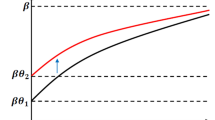Abstract
We address the issue ofcapital vs. labor income taxation in an overlapping generationsmodel with a positive externality in the human capital production.We compare the performance of the economy in the steady stateunder different tax policies. Three results are obtained. First,the size of the tax revenue required strongly affects the optimal(welfare maximizing) capital-labor income tax portfolio. Inparticular, a zero physical capital income tax rate need notbe optimal. Second, the way in which the finite life cycle issplit between the working and the retirement period also matters.And third, the size of the externality in the human capital productionalso affects the optimal income tax rate mix.
Similar content being viewed by others
References
Atkeson, A., V. V. Chari and P. J. Kehoe. (1999). “Taxing Capital Income: A Bad Idea.” Federal Reserve Bank of Minneapolis Quarterly Review 23(3), 3-17.
Auerbach, A. and L. J. Kotlikoff. (1983). “National Savings, Economic Welfare, and the Structure of Taxation.” In Martin Feldstein (ed.), Behavioral Simulation Methods in Tax Policy Analysis. NBER, The University of Chicago Press, 459-498.
Auerbach, A., L. J. Kotlikoff and J. Skinner. (1983). “The Efficiency Gains From Dynamic Tax Reform.” International Economic Review 24(1), 81-100.
Chamley, C. (1986), “Optimal Taxation of Capital Income in a General Equilibrium with Infinite Lives.” Econometrica 54(3), 607-622.
Davies, J. and J. Whalley. (1991). “Taxes and Capital Formation: How Important is Human Capital?.” D. Bernheim and J. Shoven (eds.), National Savings and Economic Performance. A National Bureau of Economic Research Project Report. Chicago and London: University of Chicago Press, 163-197.
Driffill, E. and H. Rosen. (1983). “Taxation and Excess Burden: A Life Cycle Perspective.” International Economic Review 24(3), 671-683.
Echevarría, C. A. and A. Iza. (1997). “Comprehensive Income Taxation, Investments in Human and Physical Capital, and Productivity.” Journal of Public Economics 65, 387-394.
Haley, W. J. (1976). “Estimation of the Earnings Profile from Optimal Human Capital Accumulation.” Econometrica 44, 1223-1238.
Jones, L., R. Manuelli and P. Rossi. (1993). “Optimal Taxation in Models of Endogenous Growth.” Journal of Political Economy 101(3), 485-517.
Jones, L., R. Manuelli and P. Rossi. (1997). “On the Optimal Taxation of Capital Income.” Journal of Economic Theory 73, 93-117.
Judd, K. L. (1999). “Optimal taxation and spending in general competitive growth models.” Journal of Public Economics 71, 1-26.
Lord, W. (1989). “The Transition from Payroll to Consumption Receipts with Endogenous Human Capital.” Journal of Public Economics 38, 53-73.
Lucas, R. E. Jr. (1990a). “Supply-Side Economics: An Analytical Review.” Oxford Economic Papers 42, 293-316.
Lucas, R. E. Jr. (1990b). “Why Doesn't Capital Flow from Rich to Poor Countries?.” American Economic Review 80(2) 92-96.
Milesi-Ferreti, G. M. and D. Roubini. (1998). “On the Taxation of Human and Physical Capital on Models of Endogenous Growth.” Journal of Public Economics 70, 237-254.
Nerlove, M., A. Razin, E. Sadka and R. von Weizsäcker. (1993). “Comprehensive Income Taxation, Investments in Human and Physical Capital, and Productivity.” Journal of Public Economics 50, 397-406.
Pecorino, P. (1993). “Tax Structure and Growth in a Model with Human Capital.” Journal of Public Economics 52, 251-271.
Razin, A. and C. Yuen. (1996). “Capital Income Taxation and Long-Run Growth: New Perspectives.” Journal of Public Economics 59, 239-263.
Romer, P. (1990). “Endogenous Technological Change.” Journal of Political Economy 98, (5), part 2, S71-S102.
Sargent, T. (1987). Macroeconomic Theory, 2nd Edn. Academic Press.
Seidman, L. (1983). “Taxes in a Life Cycle Growth Model with Bequests and Inheritances.” American Economic Review 73(3), 437-441.
Seidman, L. (1984). “Conversion to a Consumption Tax: The Transition in a Life-Cycle Growth Model.” Journal of Political Economy 42(2), 247-267.
Summers, L. (1981). “Capital Taxation and Accumulation in a Life Cycle Growth Model.” American Economic Review 71(4), 533-544.
Trostel, P. A. (1993). “The Effect of Taxation on Human Capital.” Journal of Political Economy 101(2), 327-350.
Uhlig, H. and N. Yanagawa (1996). “Increasing the capital income tax may lead to faster growth.” European Economic Review 40, 1521-1540.
Rights and permissions
About this article
Cite this article
Echevarria, C.A., Iza, A. Income Taxation and Finite Horizons in a Human Capital Model. International Tax and Public Finance 7, 665–689 (2000). https://doi.org/10.1023/A:1008729426519
Issue Date:
DOI: https://doi.org/10.1023/A:1008729426519




